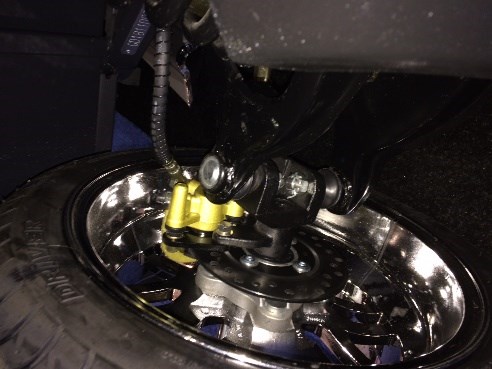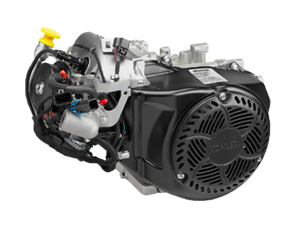The two major takeaways from the 2019 PGA Show are:
- The on-going development of feature-rich personal transportation vehicles—particularly with automotive-type features—suited to individual consumer tastes;
- The mainstreaming of lithium power and what it means for current and future product development.
The PTV shopping experience today
If you’ve been recently shopping for a personal transportation vehicle (PTV), the sales person has mostly likely been hyping automotive features. He or she will point out certain optional accessories, such as LED light package, flared fender attachments, a lift kit, a brush guard, a custom front cowl, and perhaps the “gotta have” audio system.
If you are interested in a low-speed vehicle (LSV)-qualified vehicle, to the above will be added an automotive-grade windshield, DOT Street Legal 205-50-10 radial tires, turn signals, seat belts, and the most recent regulatory requirement, a back-up camera and monitor. While the safety features of an LSV add to the cost of the vehicle, they bring the vehicle up to the level of safer driving on public access streets (speed limits at 35 m.p.h. or less), and, for that matter, on the by-ways of a golf car-dominant gated community. (If you have ever been to the golf car-crowded streets and parking lots of The Villages in Florida, you will understand why an LSV-qualified vehicle is not such a bad idea.)
PTVs become a priority for golf car manufacturers
 Long-entrenched in the fleet golf car business, the three dominant suppliers of golf car-type vehicles are now focusing on the non-golf market, consisting of PTVs and utility vehicles. Sales and marketing, along with product development are organizationally split out between the two segments to implement this recent shift in strategy.
Long-entrenched in the fleet golf car business, the three dominant suppliers of golf car-type vehicles are now focusing on the non-golf market, consisting of PTVs and utility vehicles. Sales and marketing, along with product development are organizationally split out between the two segments to implement this recent shift in strategy.
There are several implications to these changes in the industry:
- Much greater variety in features;
- More competition with new companies getting into the market;
- Continued focus on giving the golf car-type vehicle an on-road automotive feel.
Greater variety in features
The build your own movement has come to the small, golf-car-type vehicle. In particular, you see it at the Club Car and Yamaha websites where individual accessories and features can be ordered, simply by clicking on them. After you have completed your wish list, you see exactly how much it will cost you. In the case of the Club Car Onward® you start with either non-lifted or lifted versions which come off the assembly line and go from there. After you’ve put together your individualized package, the vehicle and all its attributes, delivery to the dealer is within two weeks.
E-Z-GO is accomplishing the same goal with its recent acquisition of PRO-FIT™, which specializes in E-Z-GO vehicle accessories. Notably, the company also supplies parts and accessories for E-Z-GO’s major competitors, Club Car and Yamaha.
The industry will become increasingly more efficient in coordinating product development, sales and marketing, and aftermarket service—all with the intent of matching finished product to individual consumer. You will be ordering and using your PTV much like you order and use your laptop, iPad, and cell phone. In this context of product and market development, the variety of features will, assuredly, expand and diversify.
More competition
The fact that the product offerings will be more and more tailored to individual needs and tastes, strongly suggests that there will be new entrants in the market, adding to the variety of product and increasing competition. This is a phenomenon seen in many industries, particularly in early stages of growth.
Focusing on automotive features
There are many aspects of PTVs in the current market that harken to the look and feel of a conventional, on-road vehicle. Adjustable seats, custom upholstery, dashboard displays come to mind. And of course, the LSV qualifying features mentioned above. These features were on view in exhibited vehicles from all manufacturers at the PGA Show.
Automotive features that are coming are more than skin deep. A hint of what is coming in greater numbers is seen in STAR electric vehicle’s Sirius series.
What’s “under the hood” in the coming generation of PTVs
 A visit to the STAR Electric Vehicles booth at the PGA and discussion Bob Weist, Vice President of Manufacturing, Product Development, gave a strong impression that automotive features are not simply look-and-feel accessories but also entail nitty-gritty, under-the-hood improvements that serve as the foundation for future product development. Case in point:
A visit to the STAR Electric Vehicles booth at the PGA and discussion Bob Weist, Vice President of Manufacturing, Product Development, gave a strong impression that automotive features are not simply look-and-feel accessories but also entail nitty-gritty, under-the-hood improvements that serve as the foundation for future product development. Case in point:
Under Weist’s guidance, STAR’s Sirius models have unique front and rear end suspensions. The front end suspension is a double A-arm, coil over shock construction allowing complete independent action for the two front wheels. The unique aspect of the suspension is that it incorporates upper and lower automotive-type ball joints. This feature allows adjustment in the castor, camber, and toe-in of the front wheels. To what purpose? To give the vehicle greater stability and better handling qualities through the steering system.
 STAR vehicles will also incorporate a trailing arm rear-end suspension with coil over shocks, giving independent movement to the rear wheels. The combination of the unique front end suspension and advanced suspension at the rear will give STAR vehicles an edge in the market and a secure claim to incorporating automotive technology.
STAR vehicles will also incorporate a trailing arm rear-end suspension with coil over shocks, giving independent movement to the rear wheels. The combination of the unique front end suspension and advanced suspension at the rear will give STAR vehicles an edge in the market and a secure claim to incorporating automotive technology.
Lithium in the mainstream
If the there was a single outstanding buzzword at the Show, insofar as golf cars were concerned, it would be lithium. Commercial introduction of lithium batteries last year by E-Z-GO in their Elite™line of fleet vehicles paved the way, very rapidly, to the company’s RXV and TXT models for the PTV market and in the utility vehicle market with the Cushman 800X Elite model. E-Z-GO’s success with this revolutionary introduction has put other companies in the “need to catch up” mode.
With the exception of Yamaha, other PTV manufacturers have either introduced lithium or are anticipating a near term introduction. E-Z-GO’s main opposition, Club Car, introduced at the Show its lithium-powered fleet vehicle, the Tempo, and in so doing appears to be following the pattern of introduction taken by E-Z-GO. On good authority from two sources, it is very likely that Club Car’s highly successful Onward will be sporting a lithium battery pack in the May-June time period, if not sooner.
Based on interviews with company representatives, other companies which disclosed a significant interest in a lithium solution included STAR, newcomers PILOTCAR (from Turkey), Ellwee (from Sweden), Evolution Electric Vehicles, and ETECH Electric Vehicles. The latter two companies are Chinese, and this marks the second year at the PGA Show.
For its part, Yamaha will take a more cautious approach, waiting to see more market reaction to the lithium option—and relying on its EFI engines to meet consumer and fleet requirements for distance, power, and quiet operation. Yamaha introduced its QuieTech EFI technology last year and featured it again this year. The company’s pitch, “…the quietness of electric with the profitability and dependability of gas,” pretty much sums up its current strategy.
Benefits and promise of lithium
The benefits of lithium, even though not fully developed, are destined to revolutionize PTV and utility vehicle capabilities and their associated product lines. It is much lighter, has 3.5 times the energy density compared to lead acid, and delivers a constant level of voltage throughout the discharge cycle, compared to lead acid batteries where there is a persistent voltage drop with discharge (implying much greater efficiency). Most telling is the difference in battery life cycle, that is, the number of times a battery can charge and discharge energy over a lifetime: 6,000 cycles for lithium compared 700 cycles for lead acid! Moreover, the efficiency of lithium does not degrade at high temperatures, which gives it another advantage in the Sunbelt.
ReLion Battery Company presented a 48V lithium iron phosphate battery at the PGA Show, with about the same dimensions of a typical 12V starter battery in your car or the 12V deep cycle battery from Trojan. The battery is part of the company’s InSight series, which come in 12-, 24-, and 36-volt sizes, as well. According to Christine Feodorov, Vice President of Product Development and Strategy, the batteries are designed as a drop-in replacement for the lead acid battery pack you now have in your PTV. The battery line also features a SuperSmart BMS (battery management system) which eliminates the worry about cell imbalance between batteries and maximizes performance, even when connected in parallel.
Trojan Battery, the longtime mainstay of battery power for golf cars, for its part has already introduced their lithium battery solution with the brand name, Trillium. According to Trojan’s promotional information, “Trillium is designed to be a true replacement for deep-cycle lead-acid batteries and can be used with existing lead-acid chargers with AGM/GEL settings (I-E profile).”
Both ReLion and Trojan will be targeting the aftermarket in mobile applications, particularly golf cars and PTVs, as well as light-duty utility vehicles. Various configurations of their product line will also be adaptable to many other battery-using products and systems.
It should be noted that a visit to the Garia booth confirmed that the company, the Danish firm, producers of high-end, very stylish golf cars and utility vehicles, will be using ReLion batteries.
It should be noted that there are different lithium chemistries currently available on the market for PTVs and many more in development. ReLion and Trojan use lithium iron phosphate, as does E-Z-GO with its Samsung SDI battery. Club Car’s battery, on the other hand, is a lithium-nickel-magnesium-cobalt type from Japanese manufacturer, LG Chem. Joe Deal, Club Car’s product engineer, likened the marketability and ultimate success of the various chemistries to the early competition in video taping technology and video tape players between Sony’s Beta and Panasonic’s VHS.
Implications of lithium power for the PTV and utility vehicle market
The implications for lithium power in small, task-oriented vehicles are far-reaching. Currently, the warranty for batteries in the company’s Elite line are five years. It was widely rumored, perhaps not officially announced, that the warranty would be extended another three years. Club Car’s warranty is similar and, in addition, has a one-time transferable extension for four years. According to Joe Deal, Engineering Leader, Golf Platform, the 600 W or optional 900 W chargers will fully charge the battery in 3.7 or 2.7 hours, respectively.
Just to cite a few of the implications of lithium:
- Recycled golf cars coming off golf courses, typically, on average, after four years of use will have batteries operating at 90% efficiency and still under warranty. This will result in an even larger and more competitive used vehicle market, where the economics of so-called “back-end” profits will be very significant and likely to have feedback effects on the front end sale;
- The market for used PTVs should also expand for the same reason—a virtually fully-operational battery, under warranty, enhancing the vehicle value;
- The fast charging times will make opportunity charging all the more feasible and efficient, driving the market for distributed charging systems (and reducing the need for runs to the gas station);
- Vehicle sales will, as in the automotive market, be even more driven by style enhancements and accessories;
- Moving further in the future, with the significantly greater distances that are possible with lithium power, and in tandem with permanent magnet electric motors for scalable power, look for structural enhancements that will allow public road access in most urban and suburban driving environments.
The combination of new product capabilities, leading to a broadening of the market base both inside and outside the gated community, as well as enlightened legislation should lead to exciting market growth over the next 5-7 years. And, it will be the engineers and product developers who have a command of the technology that will lead the way. Much like the cell phone phenomenon, the new technologies for small vehicles, greatly in evidence at this year’s PGA Show, will, in fact, make the market.
New EFI entries
While lithium may be the buzzword, gasoline power is hardly at the end of its road. Both E-Z-GO and Club Car featured new EFI engines and announced the end of most, if not all, carbureted models. For Club Car the Kohler closed-loop EFI will be part of the Onward lineup, as well as virtually all its other gas models, including utility vehicles. E-Z-GO introduces closed-loop electronic fuel injection (EFI) technology on all E-Z-GO RXV® and TXT® golf car models and for Cushman’s Hauler®, Refresher® and Shuttle® vehicles.
 Closed-loop technology features an internal fuel/air mix sensory system connected to an engine control unit (ECU) which can make adjustments to the mix for different driving conditions. Closed-Loop EFI engines “close the loop” between the air/fuel intake and the exhaust output to provide a constant stream of critical feedback, which optimizes power output and enhances fuel economy. The closed-loop advantage also means that closed-Loop EFI engines automatically adapt to load, weather, fuel and altitude changes, resulting in improved power, performance, reliability and increased life span of the engine.
Closed-loop technology features an internal fuel/air mix sensory system connected to an engine control unit (ECU) which can make adjustments to the mix for different driving conditions. Closed-Loop EFI engines “close the loop” between the air/fuel intake and the exhaust output to provide a constant stream of critical feedback, which optimizes power output and enhances fuel economy. The closed-loop advantage also means that closed-Loop EFI engines automatically adapt to load, weather, fuel and altitude changes, resulting in improved power, performance, reliability and increased life span of the engine.
EFI vs. Lithium Power? Let the market decide
The emphasis on new engines and motors, which was prominent at this year’s PGA Show indicates a type of risk-averting product development among the both major manufacturers and smaller companies. Companies are giving their market base, both established clients and newcomers, which they wish to attract, a diverse choice of power sources.
Ultimately, the market will decide among these power options. With the enhancement of electric power through lithium technology, which is now proving itself in both fleet and PTV applications, the odds would appear to be on the side of lithium. Moreover, there is on-going research in lithium-based batteries, and, in fact, other battery technologies, which is very likely to bring costs per kilowatt down. This is not to say that EFI engines will not be popular among many buyers, but electrification of the transportation system is moving forward at a pace which would have surprised most observers even two years ago. Lithium batteries are really the driving force behind this movement. And, as a number of Small, task-oriented vehicles (STOVs) will play their part in this trend in their traditional markets—and could well provide the leading edge in urban mobility solutions.
Legislative developments in California: Model for the Country?
California has often set the trend in automotive markets. Golf car dealer, Brian Rott, has lobbied for legislation in the State, which bodes well for PTVs and light duty utility vehicles in both the consumer and commercial sector. A conversation with Brian at the PGA Show, disclosed that he has been actively lobbying for Senate Bill 1151, which, if passed, will mandate that cities and towns throughout the State must modify their transportation plans to accept and accommodate neighborhood electric vehicles--which would include, in particular, LSVs and LSV-certified utility vehicles.
Notably, Brian is a highly successful dealer, now with four locations in Southern California. His company represents Club Car, Carryall, Onward, Garia, Polaris GEM, Taylor-Dunn, and Yamaha brands. Brian’s team aggressively seeks out commercial sales, with 13 outside salesmen making calls on potential customers in municipal and industrial markets. SB 1151 would be a major new “foot-in-the-door” for his company, and, of course, other dealerships.
Given California’s size and ability to attract national attention (for better or for worse), this legislative initiative may well result in launching similar laws throughout the country. Moreover, the focus on towns and cities fits perfectly in the trend toward green, electrified transportation systems, as well as being part and parcel of a solution to urban congestion and pollution—the key issues in urban mobility.
In summary, it may be the product development engineers that drive the market
In reviewing the vehicle trends and innovations presented at the PGA Show, perhaps the most important overall takeaway is that product engineers will drive the market. Not that new, more sophisticated products will sell themselves, but as the features of lithium power, EFI efficiency, and customized offerings to suit customer tastes and fancies become widely known, it is these features that will be key in market development and growth.
The engineers have much to work with—particularly with lithium power in the equation—and as they consistently raise performance standards, their hard work will broaden and strengthen the inclination to substitute small, task-oriented vehicles for conventional on-road consumer and work vehicles. The next 3 to 5 years will be exciting to watch.